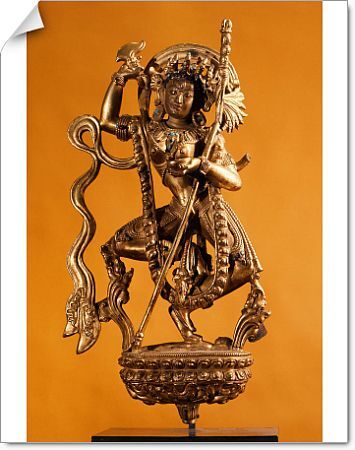
| LOST SADHANAS.ORG | THE LOST SADHANAS PROJECT |

The Yidam as mother is a most suitable form for Vajra Dakini, Green Tara, White Tara, Vajra Varahi, and Nairatmya. Indeed, all female yidams can play the role of mother, though it is avoided by Vajra Yogini (who generally takes away bodies at the burning ground rather than creating them). The mother role is caring and nurturing, supporting the young soul on its journey to enlightenment.
The role of the brother or friend can be found in emanations of Maitreya and Ratnasambhava. But bhairavas can also be brothers and friends as well. Avalokiteshvara can be a brother who helps in distress, and the Buddha of Healing can also be a trusted friend. The soul is growing out of being a child.
All yidams can take the role of teacher or guru. They may teach in different ways, but all can introduce the sambhogakaya worlds to the initiate. Perhaps Manjushri would be most helpful in this regard, as his sword traditionally cuts away illusion. This is also a role for deified humans, for figures like Padmasambhava and Naropa. It is the most common role for human lamas.
The Yidam in the protector role is usually portrayed in wrathful form. Vajrapani, Hayagriva, Vajra Yogini, Vajra Varahi, Lhamo, even forms of Amoghasiddhi, and angry forms of Manjushri can protect the soul from the lure of illusion. Wrathful forms of yoginis, bhairavas and dakinis fight off demonic attacks, protecting the soul from the poisons of hatred, desire and ignorance. Though wrathful deities are sometimes shown in Yab-Yum form, these are not the protectors of the devotional tradition. There are also benevolent protectors like Green Tara.
The bride represents passion which turns to love. Red Tara and Pandaravasini teach through love and desire for truth, while figures of the female Void reveal the infinite beauty within. Sometimes Amitabha represents temptation, which is overcome by the love of infinity, where the One overcomes the Many. Taras of white, blue, and green may also play the role of virgin bride. Both Amitabha and Ratnasambhava can act as divine lover.
The Yidam as God-emperor is often an emanation of Vajradhara or Vajrasattva. Here the Yidam brings the soul of the initiate into the celestial world, revealing both light and emptiness. In this case, the Yidam becomes translucent, and then transparent, and the mind of the initiate is fused with the buddha mind. Indeed, the Buddha himself is transparent to infinity. The soul enters the celestial palace, while infinity is spread out to encompass both aspects of the Void, infinite light and infinite emptiness. The doors to infinity can be opened by Amoghasiddhi's infinite power and creativity, Ratnasambhava's infinite love and harmony, Amitabha's infinite light and bliss, and Akshobhya's infinite purity. But for this role, Vajradhara's emanations are most appropriate as guides (these include bodhisattvas and bhairavas).
These forms of Buddhist deities bring different styles to the meditative paths, to avoid the dull sameness of progressive dissolution found in many forms of philosophical Buddhism. Transcendence is a dance, and these yidams are the cosmic partners of the soul.
Please click on the [ NEXT ] link below to continue.
[ BACK ] What is a Yidam? [ NEXT ] Yidam Reflection Versus Yidam Emanation
Introduction | Methodology - Participant/Observer | The Bodhi Tree Sadhanas | Vajra Dakini Discussion | Vajra Dakini Commentary | Vajra Dakini Sadhanas | Vajra Yogini Commentary | Maitreya Sadhanas | Vajradhara Speaks About Yidams | Lost Sadhanas Conclusion
Home
Copyright © 2021, J. Denosky, All Rights Reserved